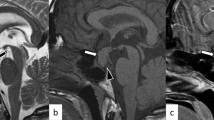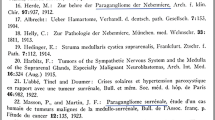Abstract
Extra-adrenal pheochromocytomas (EAPs) may arise in any portion of the paraganglion system, though they most commonly occur below the diaphragm, frequently in the organ of Zuckerkandl. EAPs probably represent at least 15% of adult and 30% of childhood phenochromocytomas, as opposed to the traditional teaching that 10% of all pheochromocytomas are at extra-adrenal sites. They may be malignant in up to 40% of the cases, though conflicting data add to the uncertainty of this point. Patients with EAPs may present with headache, palpitations, sweating, or hypertension. A small percent of patients may also be asymptomatic at presentation due to nonfunctional tumors. The diagnosis is confirmed by demonstrating elevated blood and urine levels of catecholamines and their metabolites. Imaging studies to evaluate for EAPs include CT, MRI, and 131I-labelled metaiodobenzylguanidine scintigraphy. Preoperative pharmacologic preparation, attentive intraoperative monitoring, and aggressive surgical therapy have important roles in achieving successful outcomes. Recent reports suggest that a laparoscopic approach, along with intraoperative ultrasound, can safely remove these tumors. EAPs recur and metastasize more often than their adrenal counterparts, making lifelong follow-up essential.
Similar content being viewed by others
References and Recommended Reading
Welbourn R: Early surgical history of pheochromocytoma. Br J Surg 1987, 74:594–596.
Whalen RK, Althausen AF, Daniels GH: Extra-adrenal pheochrom ocytoma. J Urol 1993, 147:1–10.
Salanatri J, Smith P, Sclicht S: Multifocal malignant extra-adrenal paragangliomas of the organ of Zuckerkandl and urinary bladder. Austrasl Radiol 2001, 45:229–232.
Glenner GG, Grimley PM: Tumors of the extra-adrenal paraganglion system. In Atlas of Tumor Pathology (2nd series). Washington DC: Armed Forces Institute of Pathology; 1974.
Carney J, Sheps S, Go V, et al.: The triad of gastric leiomyosarcoma, functioning extra-adrenal paraganglioma and pulmonary chondroma. N Engl J Med 1977, 296:1517–1518.
O’Riordain D, Young W, Grant C, et al.: Clinical spectrum and outcome of functional extradrenal paragangliomas. World J Surg 1996, 20:916–921.
Neumann H, Pawlu C, Peczkowska M, et al.: Distinct clinical features of paraganglioma syndromes associated with SDHB and SDHD gene mutations. JAMA 2004, 292:943–951.
Lenders J, Pacak K, Walther W, et al.: Biochemical diagnosis of pheochromocytomas: which test is best? JAMA 2002, 287:1427–1434.
Hwang JJ, Shoaf G, Uchio EM, et al.: Laparoscopic management of extra-adrenal pheochromocytoma. J Urol 2004, 171:72–76.
Yadav S, Singh SK, Sharma SK, et al.: Extra-adrenal pheochromocytoma: A cause of ureteral obstruction. J Urol 2000, 163:264.
Blecha M, Galanopolous C, Dharkar D, et al.: Massive organ of Zuckerkandl inducing small bowel obstruction. J Am Coll Surg 2005, 201:480–481.
Stevenson S, Ramani V, Nasim A, et al.: Extra-adrenal pheochromocytoma: an unusual cause of deep vein thrombosis. J Vasc Surg 2005, 42:570–572.
Alderazi Y, Yeh M, Robinson B, et al.: Phaeochromocytoma: current concepts. Med J Aust 2005, 183:201–204.
Ilias I, Pacak K: Current approaches and recommended algorithm for the diagnostic localization of pheochromocytoma. J Clin Endocrinol Metab 2004, 89:479–491.
Lee M, Mayo-Smith W, Hahn O: State of the art MR imaging of the adrenal gland. Radiographics 1984, 14:1015–1029.
Lumachi F, Tregnaghi A, Zucchetta P, et al.: Sensitivity and positive predictive value of CT, MRI and 123I-MIBG scintigraphy in localizing pheochromocytomas: a prospective study. Nucl Med Commun 2006, 27:583–587.
Brink I, Hoegerle S, Klisch J, et al.: Imaging of peochromocytoma and paraganglioma. Fam Cancer 2005, 4:61–68.
Fujita A, Hyodoh H, Kawamura Y, et al.: Use of fusion images of I-131 metaiodobenzylguanidine, SPECT, and magnetic resonance studies to identify a malignant pheochromocytoma. Clin Nucl Med 2000, 25:440–442.
Ilias I, Yu J, Carrasquillo JA, et al.: Superiority of 6-[18F]-fluorodopamine positron emission tomography versus [131I]-metaiodobenzylguanidine scintigraphy in the localization of metastatic pheochromocytoma. J Clin Endocrinol Metab 2003, 88:4083–4087.
Brunaud L, Bresler L, Zarnegar R, et al.: Does robotic adrenalectomy improve patient quality of life when compared to laparoscopic adrenalectomy? World J Surg 2004, 28:1180–1185.
Vargas H, Kavoussi L, Bartlett D, et al.: Laparoscopic adrenalectomy: a new standard of care. Urology 1997, 49:673–678.
Janetschek G, Finkenstedt G, Gasser R, et al.: Laparoscopic surgery for pheochromocytoma: adrenalectomy, partial resection, excision of paragangliomas. J Urol 1998, 160:330–334.
Lombardi C, Raffaelli M, De Crea C, et al.: Pheochromocytoma: role of preoperative diagnosis in the assessment of malignancy risk and in the choice of surgical approach. Suppl Tumori 2005, 4:S211.
Tagaya N, Suzuki N, Furihata T, et al.: Laparoscopic resection of a functional paraganglioma in the organ of Zuckerkandl. Surg Endosc 2002, 16:219.
Mithani SK, Marohn MR, Freischlag JA, et al.: Laparoscopic resection of a paraganglioma of the organ of Zuckerk andl in a patient with a carotid body tumor. Am Surg 2006, 72:55–59.
Walz M, Peitgen K, Neumann H, et al.: Endoscopic treatment of solitary, bilateral, multiple, and recurrent pheochromocytomas and paragangliomas. World J Surg 2002, 26:1005–1012.
Kercher KW, Heniford BT, Marroum MC, et al.: Laparoscopic intraoperative ultrasonic localization and resection of an extra-adrenal pheochromocytoma. J Laparoendosc Adv Surg Tech 1999, 9:511–515.
Goldfarb DA, Novick AC, Bravo EL, et al.: Experience with extra-adrenal pheochromocytoma. J Urol 1989, 142:931–936.
Scott H, Halter S: Oncologic aspects of pheochromocytomas: the importance of follow-up. Surgery 1984, 96:1061–1066.
Sclafani L, Woodruff J, Brennan M: Extraadrenal retroperitoneal paragangliomas: Natural history and response to treatment. Surgery 1990, 108:1124–1129.
Edstrom E, Hjelm S, Hoog A, et al.: The management of benign and malignant pheochromocytoma and abdominal paraganglioma. Eur J Surg Oncol 2003, 29:278–283.
Loh K, Fitzgerald P, Matthay K, et al.: The treatment of malignant pheochromocytoma with iodine-131 metaiodobenzylguanidine (131I-MIBG): a comprehensive review of 116 reported patients. J Endocrinol Invest 1997, 20:648–658.
Sisson J, Shapiro B, Shulkin B, et al.: Treatment of malignant pheochromocytom as with 131-I metaiodobenzylguanidine and chemotherapy. Am J Clin Oncol 1999, 22:364–370.
Safford S, Coleman E, Gockerman J, et al.: 131I metaio dobenzylguanidine is an effective treatment for malignant pheochromocytoma and paraganglioma. Surgery 2003, 134:956–962.
Rose B, Matthay KK, Price D, et al.: High-dose 131I-metaiodobenzylguanidine therapy for 12 patients with malignant pheochromocytoma. Cancer 2003, 98:239–248.
Del Pizzo JJ: Radiofrequency ablation for adrenal lesions. Curr Urol Rep 2006, 7:68.
Ishak KG, Goodman ZD, Stocker JT: Tumors of the liver and intrahepatic bile ducts. In Atlas of Tumor Pathology, 3rd series, fascicle 31. Washington DC: Armed Forces Institute of Pathology; 2001:195–196.
Lack EE: Tumors of the Adrenal Gland and Extra-adrenal Paraganglia. In Atlas of Tumor Pathology, 3rd series, fascicle 19. Washington DC: Armed Forces Institute of Pathology; 1997:261.
Author information
Authors and Affiliations
Rights and permissions
About this article
Cite this article
Disick, G.I.S., Palese, M.A. Extra-adrenal pheochromocytoma: Diagnosis and management. Curr Urol Rep 8, 83–88 (2007). https://doi.org/10.1007/s11934-007-0025-5
Published:
Issue Date:
DOI: https://doi.org/10.1007/s11934-007-0025-5




